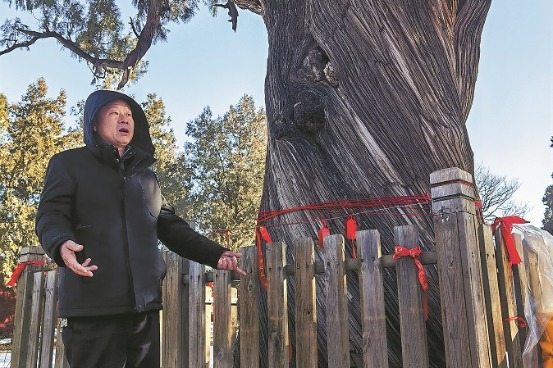Guardians of ancient trees bridge past and future
Preserved natural wonders enhance villagers' wealth, cultural connections

A real family tree
Villages and temples also preserve Huai, or Chinese scholar trees, planted by Ming Dynasty (1368-1644) migrants from Hongtong county in Shanxi, said Zhao Xiaoli, director of the Dengfeng Greening Service Center.
The scholar tree is highly regarded as a symbol of ancestral roots and a witness and marker of an area's history, Zhao said.
One such tree stands in Yuanqiao village, 10 kilometers southwest of Dengfeng. The thriving tree, over 500 years, stands more than 14 meters high and spreads an 80-square-meter canopy of leaves. Historical records show Yuanqiao was founded during the reign of Emperor Hongwu (1368-1398) in the Ming Dynasty by migrant Yuan Kecheng, who had nine children and planted nine scholar trees to remind his descendants of their Shanxi roots.
The sole surviving tree is near a small bridge, built by the Yuan family who Yuanqiao village derives its name from. Almost every family in the village has the surname Yuan.
The tree's legacy also intertwines with philanthropy.
Yuan Zhanguo, 73, chairman of Dengfeng's Dengcao Group and a native of the village, wrote in an article that he recalled childhood rituals honoring the tree as a "guardian deity".
His childhood home in front of the tree now houses Henan's first village-level charity station, established in 2015 by Yuan Zhanguo and his two brothers.
It provides seniors with monthly payments of 300 to 1,000 yuan and supports scholarships. "My parents refuse my money now, the station supports them," said 55-year-old village official Yuan Jinyi.
Yuanqiao's heritage extends beyond the tree.
A 6,000-year-old neolithic site, large-scale 300-year-old courtyard houses, and a 440-year-old fortified tower coexist with Red culture sites like the first Dengfeng Communist Party of China Congress venue.
In 2017, the Yuan brothers founded the Yuanqiao Ancient Village Conservation Company. They have invested 300 million yuan to restore the old buildings, improve the ecological and living environment, build village history museums, tourism facilities, and unique rural guesthouses.
Yuanqiao was recognized as a National 3A Scenic Area and traditional village in 2022, attracting 1 million annual visitors. "Protecting and inheriting Yuanqiao's historical culture is our biggest wish," Yuan Zhanguo's younger brother Yuan Zhanxin wrote in the 2023 book, The Story of Yuanqiao. "This isn't a quick-profit industrial project, but a legacy that will benefit generations a century from now," he wrote.
Rural gems
On Jan 25, the State Council, China's Cabinet, released the Regulations on Ancient and Notable Tree Protection, to take effect on March 15. The policy aims to safeguard these natural treasures, integrate their cultural value into festival culture and historic villages, and boost eco-tourism — a vision already realized in Leijiagou and Yuanqiao villages.
However, Dengfeng's rural gems hold untapped potential.
Donghua Town was a trade hub during the Qin Dynasty (221-206 BC) and is nestled between the Funiu Mountains and the Yinghe River, the biggest branch of the Huaihe River.
Today, the town is home to 84 ancient trees and a dozen heritage sites like the tomb of Xu You (a sage who lived over 4,000 years ago), the Cheng Kiln site (neolithic to Bronze Age relics), and the Zhouzhuang village's temple stone carvings.
The latter features seven Ming-Qing stone tablets detailing the Buddhist-Taoist Zhuyuan Temple's expansions since the 16th century and its close ties to Shaolin Temple. A scholar tree more than 500 years old stands nearby.
Zhouzhuang blends its ancient temple with bamboo groves, old watchtowers and reservoirs, railway tracks and pastoral landscapes. In spring, its rapeseed blooms and temple fairs draw crowds, while the restored temple and improved transportation and infrastructure reflect the grassroots efforts to improve the village's amenities.
Village Party secretary Zhang Haoran, 27, is a former military member-turned rural revitalizer. His plans include upgrading waste management and transforming abandoned traditional dwellings near the ancient scholar tree into boutique homestays.
"The tree witnessed my growth and the village's centuries of history. I passed by it daily as a child," Zhang said.
"Several entrepreneurs have come to inspect the construction of waterslides and sightseeing trains. We welcome investors to develop eco-cultural tourism projects, our goal is to preserve heritage while ensuring investors are satisfied."
























